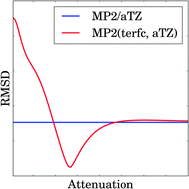Attenuated second-order Møller–Plesset perturbation theory (MP2) within the finite aug-cc-pVTZ (aTZ) basis set is developed for inter- and intra-molecular non-bonded interactions. A single attenuation parameter is optimized on the S66 database of 66 intermolecular interactions, leading to a very large RMS error reduction by a factor of greater than 5 relative to standard MP2/aTZ. Attenuation introduces an error of opposite sign to basis set superposition error (BSSE) and overestimation of dispersion interactions in finite basis MP2. A variety of tests including the S22 set, conformer energies of peptides, alkanes, sugars, sulfate–water clusters, and the coronene dimer establish the transferability of the MP2(terfc, aTZ) model to other inter and intra-molecular interactions. Direct comparisons against attenuation in the smaller aug-cc-pVDZ basis shows that MP2(terfc, aTZ) often significantly outperforms MP2(terfc, aDZ), although at higher computational cost. MP2(terfc, aDZ) and MP2(terfc, aTZ) often out-perform MP2 at the complete basis set limit. Comparison of the two attenuated MP2 models against each other and against attenuation using non-augmented basis sets gives insight into the error cancellation responsible for their remarkable success.

You have access to this article
 Please wait while we load your content...
Something went wrong. Try again?
Please wait while we load your content...
Something went wrong. Try again?


 Please wait while we load your content...
Please wait while we load your content...